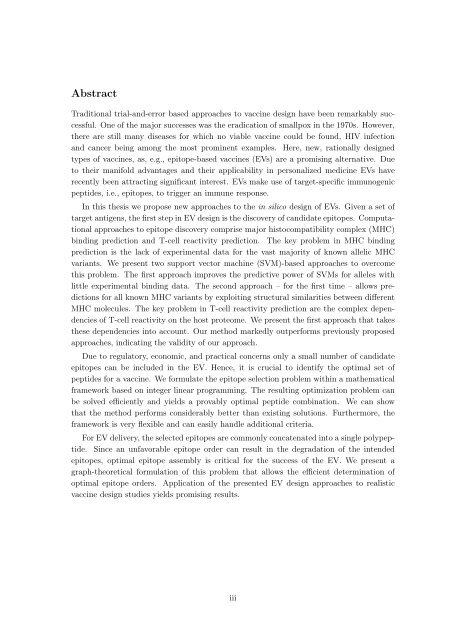New Approaches to in silico Design of Epitope-Based Vaccines
New Approaches to in silico Design of Epitope-Based Vaccines
New Approaches to in silico Design of Epitope-Based Vaccines
You also want an ePaper? Increase the reach of your titles
YUMPU automatically turns print PDFs into web optimized ePapers that Google loves.
Abstract<br />
Traditional trial-and-error based approaches <strong>to</strong> vacc<strong>in</strong>e design have been remarkably successful.<br />
One <strong>of</strong> the major successes was the eradication <strong>of</strong> smallpox <strong>in</strong> the 1970s. However,<br />
there are still many diseases for which no viable vacc<strong>in</strong>e could be found, HIV <strong>in</strong>fection<br />
and cancer be<strong>in</strong>g among the most prom<strong>in</strong>ent examples. Here, new, rationally designed<br />
types <strong>of</strong> vacc<strong>in</strong>es, as, e.g., epi<strong>to</strong>pe-based vacc<strong>in</strong>es (EVs) are a promis<strong>in</strong>g alternative. Due<br />
<strong>to</strong> their manifold advantages and their applicability <strong>in</strong> personalized medic<strong>in</strong>e EVs have<br />
recently been attract<strong>in</strong>g significant <strong>in</strong>terest. EVs make use <strong>of</strong> target-specific immunogenic<br />
peptides, i.e., epi<strong>to</strong>pes, <strong>to</strong> trigger an immune response.<br />
In this thesis we propose new approaches <strong>to</strong> the <strong>in</strong> <strong>silico</strong> design <strong>of</strong> EVs. Given a set <strong>of</strong><br />
target antigens, the first step <strong>in</strong> EV design is the discovery <strong>of</strong> candidate epi<strong>to</strong>pes. Computational<br />
approaches <strong>to</strong> epi<strong>to</strong>pe discovery comprise major his<strong>to</strong>compatibility complex (MHC)<br />
b<strong>in</strong>d<strong>in</strong>g prediction and T-cell reactivity prediction. The key problem <strong>in</strong> MHC b<strong>in</strong>d<strong>in</strong>g<br />
prediction is the lack <strong>of</strong> experimental data for the vast majority <strong>of</strong> known allelic MHC<br />
variants. We present two support vec<strong>to</strong>r mach<strong>in</strong>e (SVM)-based approaches <strong>to</strong> overcome<br />
this problem. The first approach improves the predictive power <strong>of</strong> SVMs for alleles with<br />
little experimental b<strong>in</strong>d<strong>in</strong>g data. The second approach – for the first time – allows predictions<br />
for all known MHC variants by exploit<strong>in</strong>g structural similarities between different<br />
MHC molecules. The key problem <strong>in</strong> T-cell reactivity prediction are the complex dependencies<br />
<strong>of</strong> T-cell reactivity on the host proteome. We present the first approach that takes<br />
these dependencies <strong>in</strong><strong>to</strong> account. Our method markedly outperforms previously proposed<br />
approaches, <strong>in</strong>dicat<strong>in</strong>g the validity <strong>of</strong> our approach.<br />
Due <strong>to</strong> regula<strong>to</strong>ry, economic, and practical concerns only a small number <strong>of</strong> candidate<br />
epi<strong>to</strong>pes can be <strong>in</strong>cluded <strong>in</strong> the EV. Hence, it is crucial <strong>to</strong> identify the optimal set <strong>of</strong><br />
peptides for a vacc<strong>in</strong>e. We formulate the epi<strong>to</strong>pe selection problem with<strong>in</strong> a mathematical<br />
framework based on <strong>in</strong>teger l<strong>in</strong>ear programm<strong>in</strong>g. The result<strong>in</strong>g optimization problem can<br />
be solved efficiently and yields a provably optimal peptide comb<strong>in</strong>ation. We can show<br />
that the method performs considerably better than exist<strong>in</strong>g solutions. Furthermore, the<br />
framework is very flexible and can easily handle additional criteria.<br />
For EV delivery, the selected epi<strong>to</strong>pes are commonly concatenated <strong>in</strong><strong>to</strong> a s<strong>in</strong>gle polypeptide.<br />
S<strong>in</strong>ce an unfavorable epi<strong>to</strong>pe order can result <strong>in</strong> the degradation <strong>of</strong> the <strong>in</strong>tended<br />
epi<strong>to</strong>pes, optimal epi<strong>to</strong>pe assembly is critical for the success <strong>of</strong> the EV. We present a<br />
graph-theoretical formulation <strong>of</strong> this problem that allows the efficient determ<strong>in</strong>ation <strong>of</strong><br />
optimal epi<strong>to</strong>pe orders. Application <strong>of</strong> the presented EV design approaches <strong>to</strong> realistic<br />
vacc<strong>in</strong>e design studies yields promis<strong>in</strong>g results.<br />
iii

















